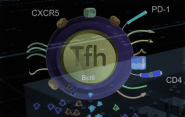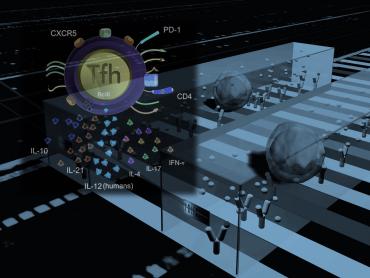Grant Advances Rong Fan's Lupus Research

T cells, a subtype of white blood cell, play a critical role in the immune system by activating another type of white blood cell known as B cells, which leads to their multiplication in response to infections. But when autoimmune lupus strikes, such as in systemic lupus erythematosus (lupus), the immune system goes awry. It creates too many antibodies - known as autoantibodies, since they go on to attack healthy tissue.
 Rong Fan, associate professor of biomedical engineering, is working on figuring out exactly how T cells, also known as T lymphocytes, and B cells interact. Doing so would be a crucial step toward improving treatment – and maybe even curing – lupus. Recently named the inaugural awardee for the Lupus Research Alliance’s new Target Identification in Lupus program, Fan has received a $600,000 grant, which will help him take his research to the next level.
Rong Fan, associate professor of biomedical engineering, is working on figuring out exactly how T cells, also known as T lymphocytes, and B cells interact. Doing so would be a crucial step toward improving treatment – and maybe even curing – lupus. Recently named the inaugural awardee for the Lupus Research Alliance’s new Target Identification in Lupus program, Fan has received a $600,000 grant, which will help him take his research to the next level.
Due to the aberrant secretion of cytokines – proteins required for cell signaling – certain T cells known as follicular helper T cells (Tfh), initiate B cell activation in lupus and promote tissue damage. Fan’s goal is to understand how the Tfh cells are communicating with the B cells. This is complicated by the fact that there are different kinds of Tfh cells – some good and some bad – and telling the difference isn’t easy.
“The challenge is how to tell Tfh cells in healthy individuals from those of a patient with lupus,” Fan said. ““Tfh cells are there even in healthy individuals, so you need to see what the Tfh cells are doing and what their functions are. Then you can distinguish between these disease-causing cells and the healthy, useful Tfh cells.”
With the grant, Fan will use a microchip platform that he developed to profile Tfh cells and analyze their role in the development of lupus. The device, known as a 45-plex protein secretion measurement platform, can trap individual cells and essentially identify each and “listen” to how the cells communicate with each other. Fan has founded the company IsoPlexis to commercialize the technology.
It’s a device with numerous potential research applications and Fan has struck up multiple collaborations. A number of years ago, he began working with Joseph Craft, M.D., the Paul B. Beeson Professor of Medicine, professor of immunobiology, and section chief of rheumatology. Craft, who specializes in lupus research, said Fan’s technology has allowed his work to advance in a way that wouldn’t otherwise be possible. While researchers in his field could look at larger cell patterns, they were previously unable to discern what was happening at the single-cell level.
“One of the problems we faced at the time was how to tell the differences between T lymphocytes in patients with lupus and healthy patients in the control groups,” Craft said. “What Rong’s technology allowed us to do was examine them at a single-cell level. His tools allowed us to characterize them as single cells and determine their phenotypic differences.”
Fan’s device can measure up to 42 cytokines on a single T cell. The preliminary research they’ve conducted so far suggests that they can tell the good from the bad Tfh cells, but they need to expand their research before they can make that judgment. “If it’s true that Tfh cells are driving the disease for some patients, now we can target those cells,” Fan said.

